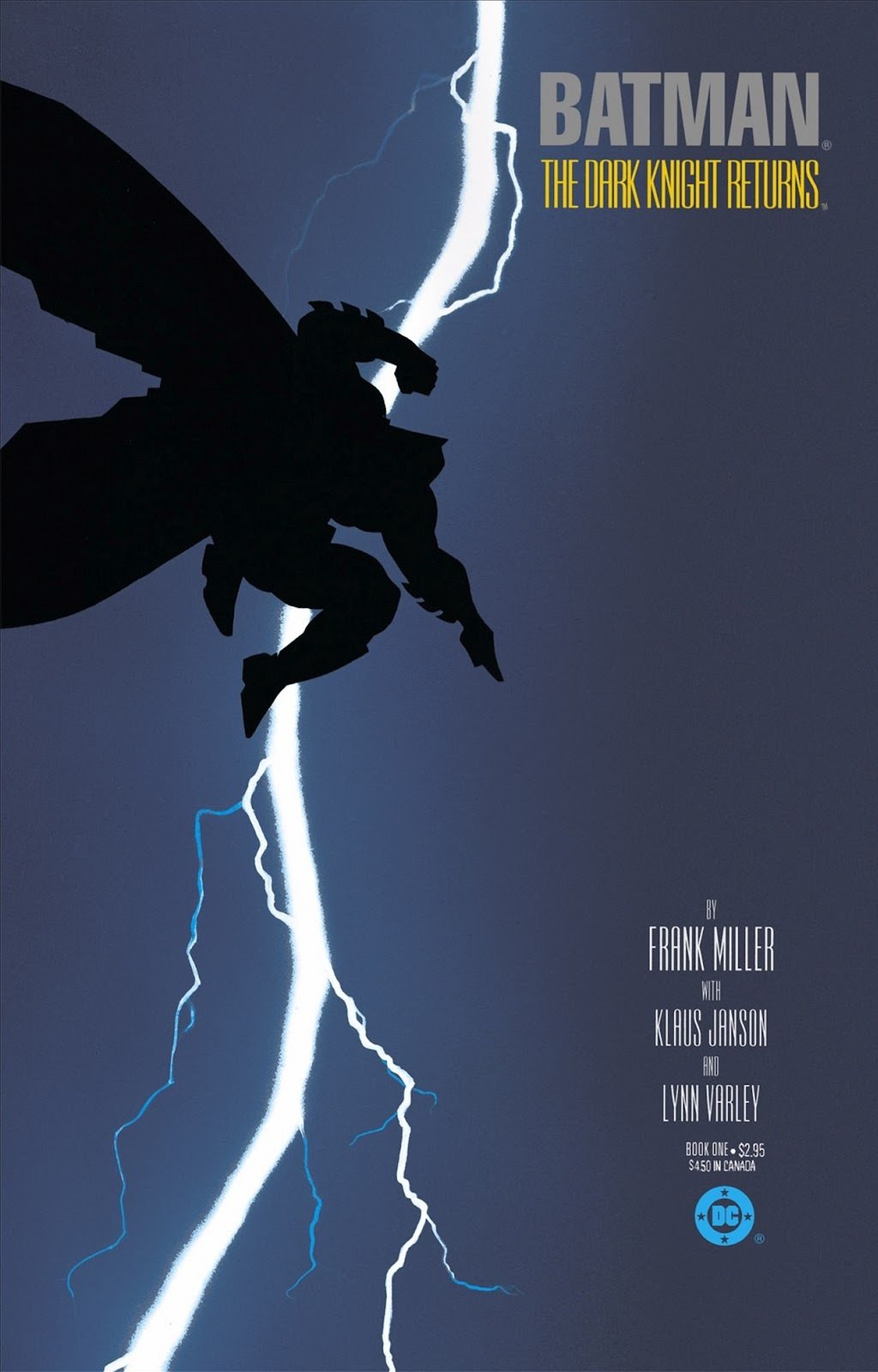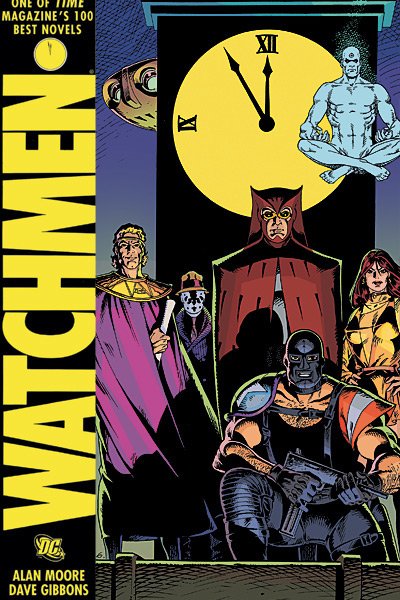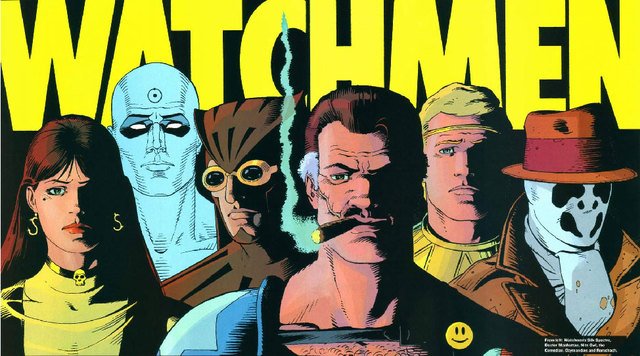From Panel to Projection Booth |6|- Lights in the Dark Age
Eoin Rogers’ series on the history of comic books looks at the role of influential authors Alan Moore and Frank Miller as they worked through darker themes, not seen in comics.
As the sheen of the Bronze Age began to wear thin it would become apparent (retrospectively of course) that the age of easily identifiable demarcations between artistic trends and thematic tropes within the publishing history of comic books was over. This doesn’t mean that thing slowed down by any means. Some of the greatest innovation and the most important publications which would establish the literary credibility of the comic book form and stamp the superhero forever into mainstream cultural consciousness were published in the 1980s. Coming out of the tailspin of the Bronze Age, superheroes were fast growing up with creators trying to cater to an ever growing adult readership and for better or worse, thanks to writers like Frank Miller and Alan Moore, superheroes were about to come of age. What followed is referred to alternatively as the Modern Age or the Dark Age, depending on who you ask, and while no single issue or character can be singled out as an exact herald there are some titles which would come to the define the age, which many believe creators have never managed to advance beyond. There are two works in particular that are probably known by most readers, be they comic book aficionados or not, that would play a pivotal role in defining the style and direction of comic books for decades to come; The Dark Knight Returns and Watchmen.
Frank Miller – The Dark Knight Returns

Frank Miller came to prominence as the artist and subsequently the writer of Marvel’s Daredevil in the early 1980s. Taking full creative control Miller managed to completely turn the title around, saving it from cancellation and making it one of Marvel’s strongest selling publications at the time. Miller’s creative influence on the character, his predilection for darker stories, moral ambiguity, and violent action would be felt industry wide as an appetite for anti-heroes grew. This process came to a dramatic head when Miller defined the arch-type in Batman: the Dark Knight Returns.
Set outside of normal continuity Miller retired Batman. Bruce Wayne, millionaire lay-about, now watches with feigned ambivalence as Gotham City slumps its way down into the gutter. Violent gangs run the streets unchecked. A rehabilitated Harvey Dent is released back into the general population. A blue and red blur protects the interests of the government. Comatose and unresponsive the Joker smiles no more.
Drawing the crime ridden streets of 1980s New York City onto the pages of The Dark Knight Returns Miller imagines a dystopian Gotham that, despite the constant droning of an incessant media sector, is without a rudder or direction. Masterfully weaving dozens of different voices into his sixteen panel page layout, from weather girls to analysts and experts, Miller creates a panoramic sense of bleak ineptitude where citizens, including Commissioner Gordon, feel totally helpless. Inevitably the storm breaks and shattering through the window pane of a mustachioed Bruce Wayne, the Dark Knight returns in a flurry of thunder, lightning, broken bones, and contusions.

Batarangs no longer hung immobile in the air but finally found purchase in the limbs of criminals who screamed for mercy. Miller’s Dark Knight, as the name suggests, was a new hero, well, anti-hero, whose thirst for justice was borne out through the liberal application of violence as opposed to the desire to do good in the world. The Dark Knight Returns is arguably Miller at his best; almost flamboyantly noir-ish dialogue, dynamic and iconic character and panel composition, and all of this conveyed through his characteristic bold and blocky line.
Batman is brutal and determined to bring justice to his city fighting against the Police Department and a government who have failed the people they were sworn to serve and protect. No institution is beyond reproach as a morally compromised Superman acts as an agent of the state. This ideological challenge is played out throughout the course of the story as Batman must first reclaim his dominance on the streets of Gotham, a story element played out in conflicts with the Mutant gang.
To match the weight of the storytelling DC published The Dark Knight Returns in a special format with square binding, as opposed to the regular staples, and specially treated glossed pages to highlight the work of colourist Lynn Varley.
The Dark Knight Returns perfectly articulated the idea of the anti-hero as a viable protagonist, establishing the zeitgeist which would be followed by comic book creators for decades to come. Bleak, dark, violent, and morally ambiguous became the new shorthand for psychological complexity.
Alan Moore – Watchmen

While The Dark Knight Returns took its cues from the pulp noir origins of Batman, Alan Moore and Dave Gibbons had an entirely different approach for Watchmen. Moore originally pitched an idea for a superhero murder mystery, which would utilize existing superheroes, to the editorial big wigs at DC. Having recently acquired the publishing rights to the character properties at Charlton Comics, Moore suggested he use those heroes, including the Question, Captain Atom, and Blue Beetle, but given the nature of the story that Moore was trying to tell DC recognised that many of these characters wouldn’t be useable after the story. The editors at DC pushed Moore to create his own characters and, basing them heavily on the Charlton Comics characters, it was so that the archetypal cast of Watchmen was born.
Dave Gibbons was brought in to pencil the comic as well as design the now iconic heroes Dr. Manhattan, Rorschach, and Nite Owl. Together he and Moore developed a nine panel page layout around which the entire miniseries, twelve issues in total, would revolve. Watchmen would go on to become the considered the greatest comic book of all time.
“Rorschach’s Journal.
October 12th, 1985:
Dog Carcass in alley this morning, tire tread on burst stomach. This city is afraid of me. I have seen its true face.
The streets are extended gutters and the gutters are full of blood and when the drains finally scab over all the vermin will drown.
The accumulated filth of all their sex and murder will foam up about their waists and all the whores and the politicians will look up and shout “save us!”…
…and I’ll look down and whisper “no.”
The opening lines help to set the tone for what is an unflinching deconstruction of the superhero. A moralizing libertarian vigilante, a near omnipotent and apathetic super-man, an impotent liberal adventurer, a hero living in the uninterrogated shadow of legacy, a performer who plays parody of the violence society allows, a pragmatist willing to make the hardest decisions for the greater good; there are no cut and dry good or bad guys in Watchmen.
Moore’s script brought a level of psychological nuance to comic books which had never been seen before. While the violence in The Dark Knight Returns may have meant that it was more appropriate for an adult readership, Watchmen was undoubted so from the beginning dealing with issues like male impotence, sexual relationships, and gendered violence. Here the comic book reading populace had seemingly been given the answer to the question “what would superheroes be like if they were real people?” Recasting a history where Nixon was elected for a third term, America won the war in Vietnam, and electric cars and e-cigarettes were the norm in the 80s, Moore envisioned not only the personal hardship and psychological damage that the violent life of a superhero would engender but also played out the social, political, technological, and existential ramifications that the arrival of the super-man would have on the human race.

Together Moore and Gibbons created a unique visual style for the comic book structuring ever page around a nine panel breakdown. Gibbon’s features an even line throughout which renders an individual visual uniformity while his meticulous attention to detail creates a sense of space that is measured and tangible. John Higgins’ colouring can at times be muted and bleak and at others captures an almost psychedelic quality in ambient lighting through incidental neon signage. All of this results in a visual style which is unique but which is also reminiscent of earlier eras of comic book illustration.
Moore and Gibbons cement the book in their formalist approach where the means of telling the story and the story itself are integral to each other. This is best seen in an issue like Fearful Symmetry where the panel composition of the entire issue is symmetrical, the center fold featuring an image of Adrian Veidt beating down an assailant with a giant V in the background, and the following and preceding composition of the panels also matches. This plays against Rorschach whose mask is based around the Rorschach inkblot test and whose backstory is detailed in the issue. Symbolism goes even deeper as images of the doomsday clock and stained smiley face punctuate the entire series establishing narrative resonance in the seemingly most mundane of mise-en-scene.
Watchmen was a commercial smash. More importantly, however, was the almost unanimous critical acclaim that the series garnered. Watchmen transcended the boundary between high and low culture to become a culturally significant artifact which many would today describe as literature and in doing so it established the literary and intellectual legitimacy of the comic book form. The series, the twelve issues collected into trade paper-back, continues its twenty nine year print history to this day.
So what?!
The Dark Knight Returns and Watchmen would influence comic book writers and artists for years to come. Miller’s stylization of the violent, morally ambiguous, anti-hero would become a ubiquitous trope within the form helping characters like Wolverine and Punisher rise to prominence in the minds of comic book readers. Watchmen helped to legitimize the form as more than just a nostalgia orientated comfort for the adult readership and illustrated that it could be used as a means of artistic expression as well as political commentary.
The vision and tone of both, equating grim, bleak, morally compromised, situations and characters as a version of fiction closer to reality than anything which had gone before, would permeate the market through the end of the 1980s and well into the 1990s and establish an industry norm the influence of which can still be seen today.
Featured Images:
wikipedia.org
nerdbastards.com
thecentrecannothold.net
dc.wikia.com

